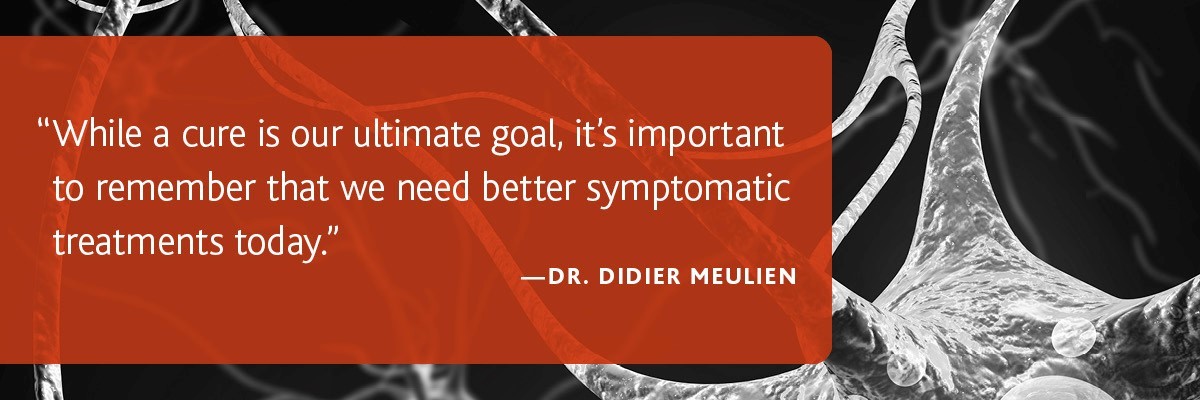Parkinson’s Research Update: Multifaceted Approach for a Multifaceted Disease
Parkinson's disease is the second most common neurodegenerative disorder in the United States, and it poses unique treatment challenges. Available therapies can provide symptomatic relief in the first years after diagnosis, but their efficacy decreases over time and long-term use is associated with significant side effects.1 There is an urgent need for new treatments that can better manage the full spectrum of symptoms over the course of the disease, as well as breakthrough therapies that could stop the disease in its tracks or even prevent it from developing at all.
Research is steadily deepening our knowledge of Parkinson’s and its complex neuropathology. We now know, for example, that Parkinson’s is a multifaceted disorder that likely involves multiple pathologies.1 Given this intricacy, there is no direct or simple path to a Parkinson’s breakthrough. That’s why Lundbeck, the only global pharmaceutical company solely focused on the brain, is taking a 360-degree approach to Parkinson’s through a diverse research program.
“We need to pursue the many angles of the disease in order to better understand its many facets and underlying causes,” says Gabrielle Hillert, MD, chief medical specialist in neurology clinical development at Lundbeck. “Only then can we develop therapies to better treat symptoms, and hopefully slow or halt disease progression.”
A look at some of the Parkinson’s research activity at Lundbeck sheds light on potential transformational approaches to addressing this complex disease.
Evolving Gold-Standard Treatment
Levodopa, which increases levels of the neurotransmitter dopamine, transformed the treatment of Parkinson’s and remains the most widely prescribed therapy. It provides effective symptomatic relief for most patients in the disease’s early stages; but over time, its effect diminishes, and many Parkinson’s patients struggle with so-called off periods, when levodopa suddenly stops working and they experience increased tremors and stiffness. In addition, long-term use is associated with dyskinesia—spontaneous, abnormal and involuntary movements.2

Dopamine agonists, compounds that mimic the effects of dopamine, can be used to enhance and prolong levodopa’s positive effects while countering its negative ones.3 But these therapies carry their own risk of side effects in some patients.3 Evolving dopamine agonist treatments is a top priority for Lundbeck researchers. “While a cure is our ultimate goal, it’s important to remember that we need better symptomatic treatments today,” says Didier Meulien, MD, lead medical specialist in neurology clinical development at Lundbeck. “We’re actively pursuing new dopamine agonist therapies so that we can better meet the needs of more patients.”
Exploring Other Neurotransmitter Disruptions
While it’s understood that dopamine deficits cause the typical motor symptoms and diverse nonmotor symptoms of Parkinson's, research suggests that Parkinson’s also involves disruptions in non-dopaminergic systems. The involvement of additional neurotransmitter systems, such as gamma-aminobutyric acid (GABA), glutamate (GLU), serotonin (5HT) acetylcholine (Ach) and noradrenaline (NA), may explain why the effectiveness of dopamine-related treatments, so dramatic in earlier stages, diminishes over time and why these treatments do not alleviate all Parkinson’s symptoms.4
“Deepening our understanding of the pathophysiological processes—some of which start well ahead of the expression of the first symptoms—could clear the way to development of new treatments that more comprehensively address the full spectrum of the disease,” says Dr. Meulien.
Targeting Alpha-Synuclein with Biologics
A key hallmark of Parkinson's disease is abnormal deposits of the protein alpha-synuclein in several different regions of the brain.1 It's still unclear what role these protein clumps play in the progression of the disease, but research shows these lesions begin developing long before the appearance of motor symptoms, and the clusters appear in more sectors of the brain as the disease progresses.1 Scientists hypothesize that inhibiting and/or clearing alpha-synuclein aggregation could stop the disease from advancing.

At Lundbeck, researchers have identified antibodies that can bind to alpha-synuclein, and they are investigating whether biologic therapy could interfere with disease progression. “In the same way that immunotherapy has transformed treatment of rheumatoid arthritis—through targeted interference with the body’s immune system—there is hope monoclonal antibodies could someday have a similar impact on Parkinson’s,” Dr. Hillert says. “The vision of a biologic therapy that specifically targets alpha-synuclein is that it could give patients a longer stable period, with well-managed symptoms and good quality of life.”
Looking for Genetic Clues
Most cases of Parkinson's occur in people with no known family history of the disorder. However, among familial cases of Parkinson’s disease, mutations have been discovered on several genes so far, including LRRK2, SNCA PARK7, PINK1, and PRKN.5 Lundbeck is exploring the genetic underpinning of the disease through our own research programs and collaborations with leading research institutions. “Understanding the genetic architecture of the disease will increase our understanding of the underlying molecular processes, and aid the discovery of biomarkers and new therapies,” Dr. Hillert explains.
Lundbeck: Deeply Committed to Parkinson’s Research
Through our diverse research programs, Lundbeck is committed to finding more effective symptomatic treatments, as well as disease-modifying therapies. As a leader in brain science, Lundbeck has an unwavering commitment to the Parkinson’s community, even as other pharmaceutical companies abandon this space because of the high risk. “Parkinson’s poses great challenges,” Dr. Meulien says, “but Lundbeck is unique in the diversity of our Parkinson’s programs and in our commitment to brain research. We’re ready for the challenge.”
Sources
1. Kalia LV, Lang AE. Parkinson's disease. Lancet. 2015;386(9996):896-912.
2. Parkinson.org, Levodopa. https://www.parkinson.org/Understanding-Parkinsons/Treatment/Prescription-Medications/Levodopa. Accessed 11/19/2019.
3. Khanam S, Siddique YH. Dopamine: agonists and neurodegenerative disorders. Curr Drug Targets. 2018;19(14):1599-1611.
4. Sanjari Moghaddam H, Zare-Shahabadi A, Rahmani F, Rezaei N. Neurotransmission systems in Parkinson's disease. Rev Neurosci. 2017;28(5):509-536.
5. Parkinson’s Disease: Genetics Home Reference. National Institutes of Health. https://ghr.nlm.nih.gov/condition/parkinson-disease#diagnosis. Accessed 11/19/2019.
UBR-C-100182v2


